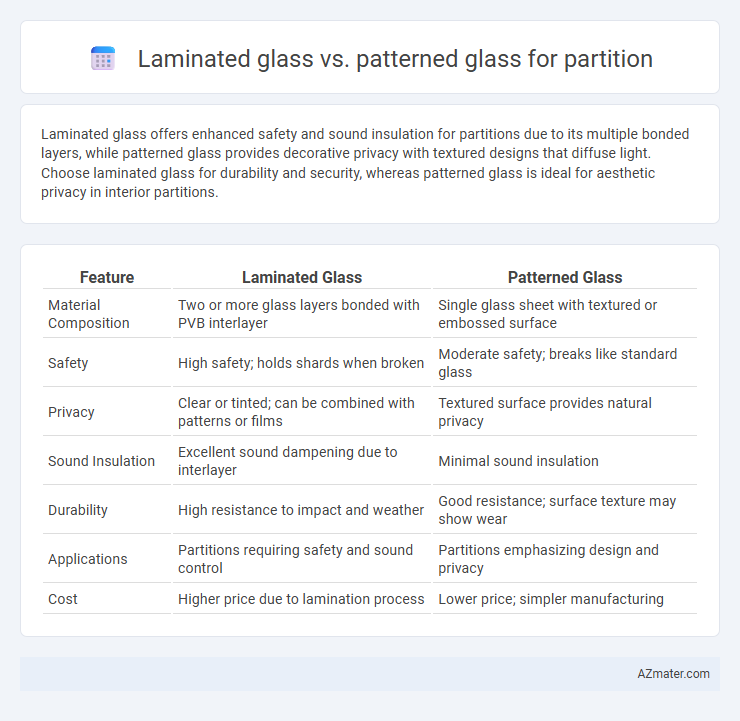Laminated glass offers enhanced safety and sound insulation for partitions due to its multiple bonded layers, while patterned glass provides decorative privacy with textured designs that diffuse light. Choose laminated glass for durability and security, whereas patterned glass is ideal for aesthetic privacy in interior partitions.
Table of Comparison
| Feature | Laminated Glass | Patterned Glass |
|---|---|---|
| Material Composition | Two or more glass layers bonded with PVB interlayer | Single glass sheet with textured or embossed surface |
| Safety | High safety; holds shards when broken | Moderate safety; breaks like standard glass |
| Privacy | Clear or tinted; can be combined with patterns or films | Textured surface provides natural privacy |
| Sound Insulation | Excellent sound dampening due to interlayer | Minimal sound insulation |
| Durability | High resistance to impact and weather | Good resistance; surface texture may show wear |
| Applications | Partitions requiring safety and sound control | Partitions emphasizing design and privacy |
| Cost | Higher price due to lamination process | Lower price; simpler manufacturing |
Introduction to Glass Partitions
Glass partitions enhance interior spaces by combining functionality with modern aesthetics, offering clear divisions without compromising light flow. Laminated glass, composed of two or more layers bonded with an interlayer, provides superior safety, sound insulation, and durability, making it ideal for high-traffic or secure environments. Patterned glass introduces design and privacy through textured or frosted surfaces, adding visual interest while diffusing light and obscuring visibility, suitable for creative or private partition applications.
What is Laminated Glass?
Laminated glass is a safety glass consisting of two or more glass layers bonded with an interlayer, usually made of polyvinyl butyral (PVB) or ethylene-vinyl acetate (EVA), providing enhanced strength and impact resistance. It reduces the risk of injury by holding shards in place when broken, making it ideal for partitions requiring both safety and sound insulation. Its superior durability and clarity distinguish it from patterned glass, which primarily focuses on decorative texture and privacy.
What is Patterned Glass?
Patterned glass features textured surfaces created by pressing patterns onto molten glass, offering enhanced privacy and decorative appeal for partitions. Unlike laminated glass, which consists of layers bonded with a plastic interlayer for safety and strength, patterned glass primarily emphasizes aesthetic design while diffusing light effectively. Common patterns include reeded, hammered, and frosted, providing versatile options to complement interior spaces while maintaining partial visibility.
Aesthetic Differences: Laminated vs Patterned Glass
Laminated glass offers a sleek, smooth surface with enhanced clarity, providing a modern and minimalistic aesthetic ideal for partitions that emphasize transparency and light transmission. Patterned glass, on the other hand, features textured surfaces and decorative designs that diffuse light and create privacy while adding visual interest and artistic appeal to partition walls. Choosing between laminated and patterned glass depends on whether the priority is clean, unobstructed views or stylistic texture and subtle obscurity in interior design.
Safety and Security: Which is Superior?
Laminated glass provides superior safety and security for partitions due to its multi-layer construction that holds shards together upon impact, reducing the risk of injury and deterring forced entry. Patterned glass, while offering privacy and aesthetic appeal, lacks the same level of impact resistance and shatterproof qualities, making it less effective in preventing break-ins or accidents. Choosing laminated glass enhances both occupant protection and asset security in partition applications.
Acoustic Performance Comparison
Laminated glass offers superior acoustic performance compared to patterned glass due to its interlayer composition, which effectively dampens sound vibrations and reduces noise transmission. Patterned glass, while providing visual privacy and aesthetic appeal, lacks the soundproofing benefits as it is typically a single-pane structure without additional layers to absorb sound. For partitions requiring optimal noise control, laminated glass is the preferred choice, achieving higher Sound Transmission Class (STC) ratings and enhanced acoustic insulation.
Light Transmission and Privacy Factors
Laminated glass provides high light transmission, allowing natural light to pass through while maintaining privacy through opaque interlayers or tinted options, making it ideal for partitions requiring visibility control. Patterned glass offers variable light diffusion with decorative textures that obscure direct views but still permit ambient light, enhancing privacy without sacrificing brightness. Choosing between laminated and patterned glass depends on the balance needed between transparency and privacy in partition design.
Durability and Maintenance
Laminated glass offers superior durability for partitions by combining multiple glass layers with an interlayer that resists impact, preventing shattering and enhancing safety. Patterned glass, while aesthetically versatile, is generally less robust and more prone to surface scratches and wear over time, affecting its longevity in high-traffic areas. Maintenance of laminated glass is simpler due to its smooth surface, whereas patterned glass requires careful cleaning to avoid damage to its textured design.
Cost Analysis: Laminated vs Patterned Glass
Laminated glass typically incurs higher upfront costs due to its multi-layer construction and safety features, making it a more expensive option for partitions compared to patterned glass. Patterned glass offers a cost-effective alternative with lower manufacturing expenses and versatile design options, suitable for budget-conscious projects without compromising aesthetics. Long-term maintenance costs are generally comparable, but laminated glass provides superior durability and safety benefits that may justify the initial investment in commercial partition installations.
Best Applications and Recommendations
Laminated glass is best suited for partitions requiring enhanced safety and sound insulation, making it ideal for office spaces, conference rooms, and areas with high foot traffic. Patterned glass excels in applications demanding privacy without compromising light transmission, such as bathroom partitions, decorative office dividers, and retail display areas. For optimal partition design, use laminated glass in environments prioritizing security and acoustic control, while patterned glass is recommended where aesthetic appeal and partial obscurity are desired.

Infographic: Laminated glass vs Patterned glass for Partition
 azmater.com
azmater.com